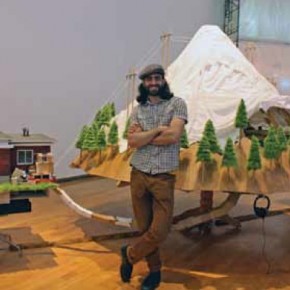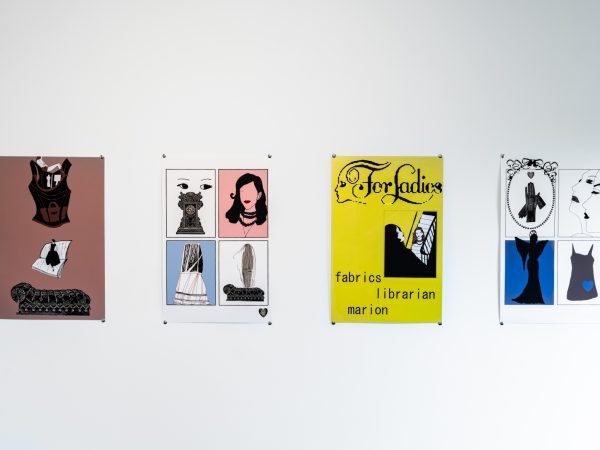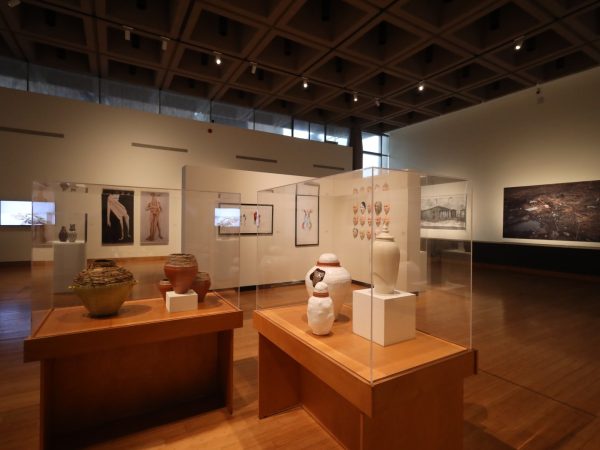
resting on a map of Halifax on Eyelevel Gallery’ s floor. February 2012 .
Photo: Eli Gordon
“It’s been a few years, I’m trying to remember how it started.” Tom Young and I are sitting in the entranceway of the Eyelevel Gallery in Halifax. It’s February and we are at the launchparty for the Black Rabbit Arts Festival, a month-long series of playful events for the arts community.
Black Rabbit features sculptural toboggan races, an amateur lecture series, cardboard costumery, community feasting, workshops and much more. Tom is trying to explain how this North End Haligonian event sprung forth from the week-long White Rabbit Artist Residency and Festival, which he has been hosting at his Red Clay Farm since 2009. “It’s almost like there was an incubation at White Rabbit that led to the creation of Black Rabbit.”
Each summer, the White Rabbit Festival provides an annual opportunity for 15 artists to escape the hustle and bustle of urban life to explore and expand on the potential of the natural world at the edge of the Bay of Fundy. The residency has been likened to a summer camp more than once—not just for the outdoorsy earth connection, but also for the lasting relationships that are built between artists.
“You share this really special and intimate and sort of otherworldly experience,” says Louise Hanavan, who is an organizer of both Rabbits. “Interestingly, when you come back to the city maybe you’re not that close of friends, but whenever you see each other in town you share this really special connection, and there’s this look you give each other because you shared this really surreal experience.”
The surreality of the White Rabbit experience is reflected in the art created throughout the duration of the residency. Each artist seeks out a work site somewhere on the farmland with choices ranging from forested nooks to rounded ponds, sloping orchards and a hidden sauna house. At these sites, most artists use the materials provided by the natural world. Young explains that there is no physical permanence to the installations at White Rabbit: “We didn’t really set any firm conditions on how people made their work. It just had to be something that either fit with the landscape or it was ephemeral. So people could have all kinds of hardware out in the woods, and most of the work has tended to be more ephemeral.”
Halifax artist Brian Riley has been a Rabbit for two years now. He explains that his process was to enter a site and work through the question “How do you spend time in a space and ask it what it wants.” During his first residency he found an old birch tree that had fallen with its various limbs and shards scattered around it. He then organized these pieces into colour gradient spirals. “It’s like combing your hair, like combing the hair of that area,” he muses about his process.
At the end of the week-long residency, the farm opens up to the public for a nighttime festival of art exploration. It’s at this time that the surreal nature of White Rabbit hits its peak. Each site is given a different kind of life as it is entered. The once-isolated location that just held an artist and maybe a radio—playing the White Rabbit pirate radio station—shifts as people weave through the farm’s paths and engage with the works created.
Despite—or because of—the ethereal nature of the art created at White Rabbit and the temporary nature of the brief residency, a separate kind of permanence has evolved. The sense of connection and collaboration between resident Rabbits has extended beyond that summered week and given birth to Black Rabbit.

“The way I see it is that there’s people who built relationships between each other and sort of took away an inspiration from it that has created a really good energy I think,” says Young. He gazes contentedly at the artists and attendees buzzing about Eyelevel Gallery during the Black Rabbit launch party, in which exhibiting artists explored the themes of “light” and “darkness” on the gallery’s walls. Young responded to the needs of a community in need of a playful, wintertime escape:

“A bunch of artists who were at White Rabbit said they wanted to have a winter version of White Rabbit in Halifax, and then I realized, winter’s long and it’s hard you know?”
Oh, I know. I know that winter is not summer and that gallery walls are not forested nooks, but circling the Eyelevel on this first night of Black Rabbit, there is a lightness in the air as the darkness envelops the streets beyond the doors. The artists of Halifax are finding the heat in each other. For the month of February, they cultivated, collaborated and created. They reclaimed those ethereal truths they found in the natural world, and come August they will have each other.
Veronica Simmonds is a word worker, information seeker and sound enthusiast currently cultivating curiosities in coastal Canada. Her work can be found in The Coast, Spacing Magazine, OpenFile, Poets and the News and on CKDU 88.1.

Photo: Eli Gordon

February 2012. Photo: Eli Gordon








Leave a Reply